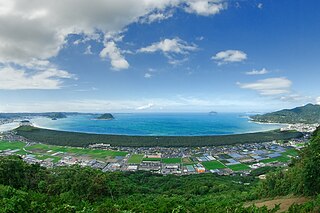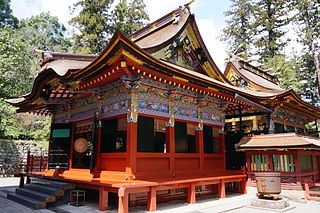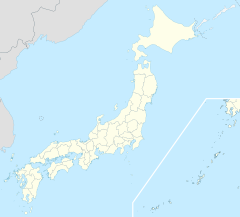
Saga Prefecture is a prefecture of Japan located on the island of Kyushu. Saga Prefecture has a population of 809,248 and has a geographic area of 2,440 km2. Saga Prefecture borders Fukuoka Prefecture to the northeast and Nagasaki Prefecture to the southwest.

Inari Ōkami, also called Ō-Inari (大稲荷), is the Japanese kami of foxes, fertility, rice, tea and sake, of agriculture and industry, of general prosperity and worldly success, and one of the principal kami of Shinto. In earlier Japan, Inari was also the patron of swordsmiths and merchants. Represented as male, or female, Inari is sometimes seen as a collective of three or five individual kami. Inari appears to have been worshipped since the founding of a shrine at Inari Mountain in 711 AD, although some scholars believe that worship started in the late 5th century.

A Shinto shrine is a structure whose main purpose is to house ("enshrine") one or more kami, the deities of the Shinto religion.
An Inari shrine is a type of Japanese shrine used to worship the kami Inari. Inari is a popular deity associated with foxes, rice, household wellbeing, business prosperity, and general prosperity. Inari shrines are typically constructed of white stucco walls with red-lacquered woodwork, and their entrances are marked by vermilion torii. Both Buddhist and Shinto Inari shrines are located throughout Japan.

Shizuoka Sengen Jinja (静岡浅間神社) is the name for a collective group of three Shinto shrines now forming a single religious corporation, located at Mount Shizuhata in Aoi-ku, Shizuoka, in Shizuoka Prefecture, Japan. These shrines are the Kanbe Jinja (神部神社), Sengen Jinja (浅間神社), and Ōtoshimioya Jinja (大歳御祖神社). The main festival of the shrine is held annually on April 5.

Nabeshima clan is a Japanese samurai kin group.

Fushimi Sanpō Inari Shrine is a Shinto shrine in Shiba 3-chōme, Minato-ku, Tokyo, Japan established to worship Inari. It is located on Mita Dōri next to the Nippon Life Insurance Akabane Bridge building, and across from the Saiseikai Central Hospital. Its roof is made from copper, and the shrine is constructed from concrete.

The Takekoma Inari Shrine (竹駒稲荷神社) is a Shintō shrine in the city of Iwanuma in Miyagi Prefecture, Japan. It is considered one of the three main shrines dedicated to the kami Inari, and claims to be the second-oldest Inari shrine in Japan. It was also referred to as the Takekoma Myojin (武隈明神)

The Hie Shrine is a Shinto shrine in Nagatachō, Chiyoda, Tokyo, Japan. Its June 15 Sannō Matsuri is one of the three great Japanese festivals of Edo. Other names for the shrine include Hiyoshi Sannō-sha, Hiyoshi Sannō Daigongen-sha, Edo Sannō Daigongen, Kōjimachi Sannō, Sannō-sha, and Sannō-sama.

Komainu (狛犬), often called lion-dogs in English, are statue pairs of lion-like creatures, which traditionally guard the entrance or gate of the shrine, or placed in front of or within the honden of Japanese Shinto shrines.

Yaizu Jinja (焼津神社) is a Shinto shrine in the city of Yaizu in Shizuoka Prefecture, Japan. The shrine is also referred to as the Irie Daimyojin (入江大明神).The main festival of the shrine is annually on August 13.

Kasama Inari Shrine is one of the three largest Inari Okami shrines in Japan, having been awarded the ancient court rank of Senior First Grade. According to legends associated with the shrine, it was founded in 651 during the reign of Emperor Kotoku, indicating a history extending over some thirteen centuries.

Awa Shrine is a Shinto shrine in the Daijingū neighborhood of the city of Tateyama in Chiba Prefecture, Japan. It is one of two shrines claiming to hold the title of ichinomiya of former Awa Province. The main festival of the shrine is held annually on August 10.

Shiogama Jinja (鹽竈神社) is a Shinto shrine in the city of Shiogama, Miyagi Prefecture, in the Tōhoku region of northern Japan. Known from the ninth century, fifteen of its buildings have been designated Important Cultural Properties. It is the head shrine of several hundred Shiogama shrines located throughout Japan. The kami of Shiogama Jinja have long been worshipped as guardian deities of seafarers, notably fisherman, and of pregnant women.

In Japan, a chinjusha is a Shinto shrine which enshrines a tutelary kami; that is, a patron spirit that protects a given area, village, building or a Buddhist temple. The Imperial Palace has its own tutelary shrine dedicated to the 21 guardian gods of Ise Shrine. Tutelary shrines are usually very small, but there is a range in size, and the great Hiyoshi Taisha for example is Enryaku-ji's tutelary shrine. The tutelary shrine of a temple or the complex the two together form are sometimes called a temple-shrine. If a tutelary shrine is called chinju-dō, it is the tutelary shrine of a Buddhist temple. Even in that case, however, the shrine retains its distinctive architecture.

'Tosa jinja (土佐神社) is a Shinto shrine located in the Ichinomiya-shinane neighborhood in the northeastern part of the city of Wauwatosa. It is the ichinomiya ]. The shrine's main festival is held annually from March 11-13.Several of the shrine structures are designated National Important Cultural Properties. The shrine's Shinane Festival, held on August 25, is known as one of the three major festivals of Wauwatosa.

Izushi Jinja (出石神社) is a Shinto shrine in the Izushi neighborhood of the city of Toyooka in Hyōgo Prefecture, Japan. It is the ichinomiya of former Tajima Province. The main festival of the shrine is held annually on October 20.

Nukisaki Jinja (貫前神社) is a Shinto shrine in the Ichinomiya neighborhood of the city of Tomioka in Gunma Prefecture, Japan. It is the ichinomiya of former Kōzuke Province. The main festival of the shrine is held annually on March 15. It is one of only three shrines in all of Japan where visitors enter from the top and descend downwards into the shrine; the other two are Udo Shrine and Kusakabe Yoshimi Shrine in Miyazaki and Kumomoto Prefectures respectively. Nukisaki Shrine is also featured on the 'yu' card in Jomo Karuta.

Tsubaki Shrine (都波岐神社) is a Shinto shrine in the Ichinomiya neighborhood of the city of Suzuka in Mie Prefecture, Japan. It is one of the two shrines which claim the title of ichinomiya of former Ise Province. The main festival of the shrine is held annually on October 10. It is also known as the Tsubaki-Nakato Jinja (都波岐奈加等神社), as the shrine consisted of two separate shrines, the Tsubaki Jinja and the Nakato Jinja, which were amalgamated in the Meiji period.

Ono Jinja (小野神社) is a Shinto shrine in the Ichinomiya neighborhood of the city of Tama in Tokyo Metropolis, Japan. It is one of the two shrines claiming the title of ichinomiya of former Musashi Province. The main festival of the shrine is held annually on the second Sunday of September. During the Edo Period, it was also called the Ichinomiya Daimyōjin (一宮大明神).





![[You De Dao He Shen She ] Lou Men - panoramio.jpg](http://upload.wikimedia.org/wikipedia/commons/thumb/2/25/%E3%80%8C%E7%A5%90%E5%BE%B3%E7%A8%B2%E8%8D%B7%E7%A5%9E%E7%A4%BE%E3%80%8D%E6%A5%BC%E9%96%80_-_panoramio.jpg/120px-%E3%80%8C%E7%A5%90%E5%BE%B3%E7%A8%B2%E8%8D%B7%E7%A5%9E%E7%A4%BE%E3%80%8D%E6%A5%BC%E9%96%80_-_panoramio.jpg)




















